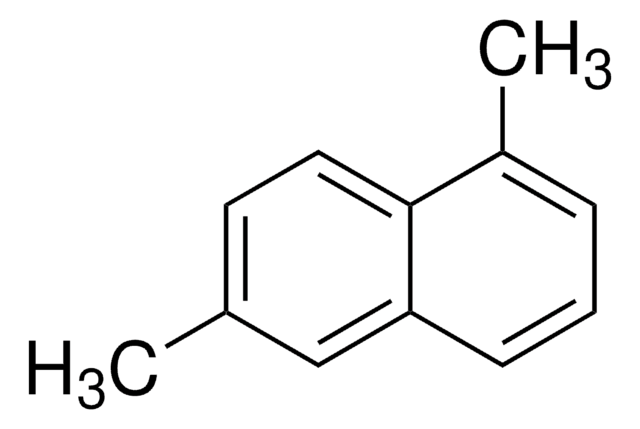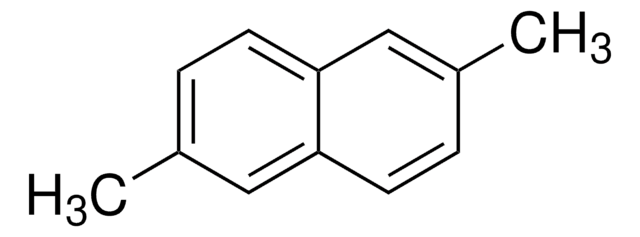About This Item
Fórmula linear:
C10H6(CH3)2
Número CAS:
Peso molecular:
156.22
Beilstein:
2039378
Número CE:
Número MDL:
Código UNSPSC:
12352100
ID de substância PubChem:
NACRES:
NA.22
Produtos recomendados
Nível de qualidade
Ensaio
96%
Formulário
liquid
índice de refração
n20/D 1.609 (lit.)
p.e.
263 °C (lit.)
densidade
0.982 g/mL at 25 °C (lit.)
cadeia de caracteres SMILES
Cc1cc(C)c2ccccc2c1
InChI
1S/C12H12/c1-9-7-10(2)12-6-4-3-5-11(12)8-9/h3-8H,1-2H3
chave InChI
QHJMFSMPSZREIF-UHFFFAOYSA-N
Informações sobre genes
human ... CYP1A2(1544)
Procurando produtos similares? Visita Guia de comparação de produtos
Palavra indicadora
Warning
Frases de perigo
Declarações de precaução
Classificações de perigo
Aquatic Acute 1 - Aquatic Chronic 1
Código de classe de armazenamento
10 - Combustible liquids
Classe de risco de água (WGK)
WGK 3
Ponto de fulgor (°F)
228.2 °F - closed cup
Ponto de fulgor (°C)
109 °C - closed cup
Equipamento de proteção individual
Eyeshields, Gloves
Escolha uma das versões mais recentes:
Já possui este produto?
Encontre a documentação dos produtos que você adquiriu recentemente na biblioteca de documentos.
Os clientes também visualizaram
Odd G Brakstad et al.
Chemosphere, 204, 87-91 (2018-04-14)
Hydrocarbon biodegradation may be slower in cold Arctic than in temperate seawater, and this will affect the toxicity time window of the hydrocarbons. In this study, the acute toxicities of water-soluble phases of 1,3-dimethylnaphthalene, phenanthrene, fluoranthene, and low energy water-accommodated
Tjalling Jager et al.
Environmental science & technology, 51(13), 7707-7713 (2017-06-10)
Efficiently assessing and managing the risks of pollution in the marine environment requires mechanistic models for toxic effects. The General Unified Threshold model for Survival (GUTS) provides a framework for deriving toxicokinetic-toxicodynamic (TKTD) models for the end point survival. Two
Sangwoo Lee et al.
Environmental science. Processes & impacts, 19(9), 1117-1125 (2017-08-08)
Polycyclic aromatic hydrocarbons (PAHs) and alkylated PAHs are known to be major toxic contaminants in spills of petroleum hydrocarbons (oil). Spilled oil undergoes weathering and over time, PAHs go through a series of compositional changes. PAHs can disrupt endocrine functions
Xu-Hui Huang et al.
Food & function, 12(4), 1626-1638 (2021-01-22)
Clam is a kind of nutritious, delicious and economical aquatic food around the world and is famous for its unique aroma. Instrumental analysis, sensory analysis, and comprehensive statistical analysis were performed to explain the relationship between aroma and odorants in
Nien-Hsin Kao et al.
Marine pollution bulletin, 97(1-2), 319-332 (2015-06-08)
Three fishing harbors were investigated to study the polycyclic aromatic hydrocarbons in the sediments and trace possible anthropogenic sources by identification of cyclic terpenoid biomarkers. Seventeen terpanes, 10 steranes and 10 bicyclic sesquiterpanes in the marine diesel and the three
Nossa equipe de cientistas tem experiência em todas as áreas de pesquisa, incluindo Life Sciences, ciência de materiais, síntese química, cromatografia, química analítica e muitas outras.
Entre em contato com a assistência técnica












